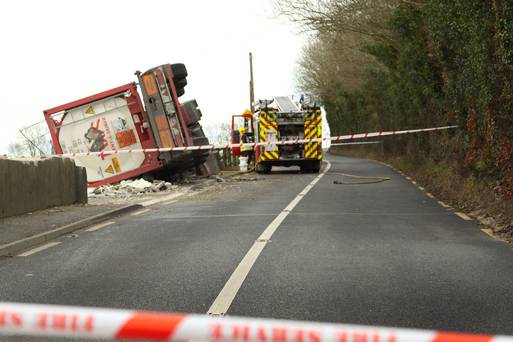The current spate of over turned trucks and shedding loads are reaching levels that must be of concern to the Road Safety Authority, the Health and Safety Authority, An Garda Siochana, Insurance Companies, the road transport Industry and the general public.
The cause of these incidents can be as a result of mechanical failure, over loading, insufficient load restraining or restraint failure, Driver fatigue, Driver inattentiveness, Driver inexperience, poor road surface, extreme weather conditions or excessive speed.
Based on figures obtained from the UK it is conservatively estimated that approximately two trucks overturn or shed their load per week in Ireland. HGV overturns have resulted in fatalities, amputations and serious injuries to drivers and the public. In the UK there are 4,000 successful prosecutions against drivers and operators for unsafe loads. (Freight Best Practice, 2011). An Garda Siochana do their very best with the resources they have. However, it is up to professional drivers to ensure that they and their colleagues, employers and customers are aware of the dangers of over loading and poor loading practice and inadequate load restraint.

From the Professional Drivers perspective, the key factors to avoid overturns and load shedding are the following;
- Ensure that you are fit to drive.
- Ensure that you have completed a pre-trip vehicle inspection.
- Ensure that your load is properly loaded and secured.
- Ensure that you stick to the speed limits.
- Do not allow distractions such as mobile phones or navigation screens cause distraction.
- Adjust speed to compensate for load type, poor road surface and weather conditions.
- If you have any doubts about a load, get advice from a suitably qualified person.

From the professional drivers perspective, most overturns will be caused by excess speed as a result of inexperience or inattentiveness. Drivers must know the limits of the vehicles safe handling parameters, must be fully attentive while at the wheel and know the signs of fatigue.
All Drivers must pay attention to speed limits. While 30 kph may seem too slow for some vehicles, it is very important that all Drivers observe the speed limit regardless of the vehicle they are driving. This is simply because it will deter inexperienced HGV Drivers from feeling that they are holding up traffic by driving at 30kph. It can be seen by most drivers operating around the M50, Red Cow (Junction 8), Liffey Valley (Junction 7), Blanchardstown (Junction 6) and Finglas (junction 5) that the majority of Drivers excessively speed in these 50 kph & 30 kph zones. Drivers of smaller vehicles put themselves in very dangerous positions when driving alongside over speeding HGV’s on motorway ramps.
The risk of overturning or shedding a load as a result of speed is eliminated if drivers observe the maximum speed limits in these high-risk areas. Across Europe there are similar road junctions like those on the M50 that require reduced speed controls to ensure against vehicle turnovers and or load shedding.
All Drivers should observe and not exceed the maximum speed. Driving a HGV is a very easy job to do poorly and a very demanding and rewarding job to do well.
If HGV drivers want to be treated like a professional they must act like professionals.
